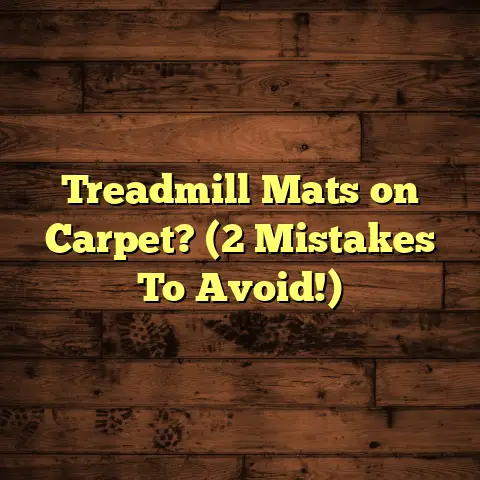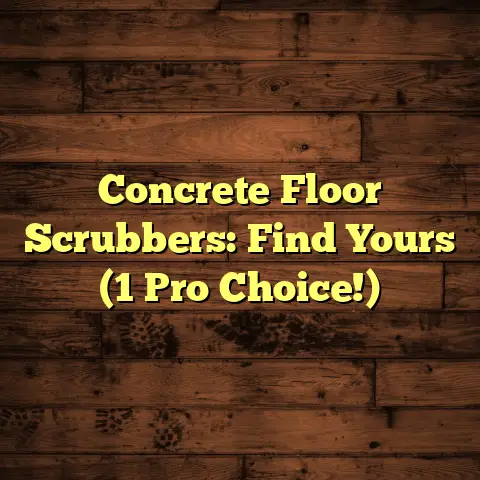Shed On Concrete: Is It Okay? (6 Foundation Fails!)
We’re talking storage solutions, workshops, even she-sheds and man-caves!
But before you rush out and plop that pre-fab shed onto your existing concrete slab, let’s talk foundations. More specifically, let’s talk about whether that concrete is really ready for the job.
Concrete seems like a no-brainer, right? Durable, resistant to pests, and seemingly impervious to rot. And while those things are true, there are some hidden dangers lurking beneath the surface – literally.
I’m here to tell you that while concrete can be a solid foundation, there are specific “foundation fails” that can lead to issues down the line. These aren’t always obvious, but trust me, ignoring them can cost you big time in repairs and headaches.
So, grab a coffee, settle in, and let’s dive into the world of sheds on concrete and how to avoid these costly mistakes.
Understanding Concrete as a Foundation
Concrete is a powerhouse building material. It’s basically a mix of cement, water, and aggregates (like sand and gravel) that hardens into a rock-solid mass.
But why is it so popular for shed foundations?
Well, for starters, it’s incredibly durable. A properly poured and cured concrete slab can withstand a ton of weight and resist the elements for years.
Plus, it’s relatively easy to clean, and compared to wooden foundations, it’s far less susceptible to moisture damage, pests, and rot.
There are several types of concrete foundations commonly used for sheds:
-
Slabs: These are the most common. A flat, level concrete surface poured directly onto the ground (after proper prep, of course!).
-
Piers: Concrete columns that support the shed’s frame, lifting it off the ground. Great for uneven terrain.
-
Footings: Buried concrete structures that provide a solid base for walls or posts. Often used in conjunction with piers.
The advantages of using concrete are clear:
-
Moisture Resistance: Concrete doesn’t rot or decay like wood, making it ideal for damp environments.
-
Ease of Cleaning: Spills and dirt are easily wiped away.
-
Structural Integrity: A well-built concrete foundation provides a stable and level base for your shed.
But here’s where things get interesting. There are some common misconceptions about concrete foundations that can lead homeowners astray.
One of the biggest is that “concrete is indestructible.” It’s strong, yes, but it’s not immune to the forces of nature.
Another misconception is that “any concrete slab will do.” That old patio slab might look sturdy, but it might not be up to the task of supporting a fully loaded shed.
These misconceptions set the stage for the foundation fails we’re about to explore. These are the mistakes I’ve seen time and time again that lead to cracked slabs, rotting sheds, and frustrated homeowners.
The Six Foundation Fails
Alright, let’s get down to the nitty-gritty. These are the six biggest mistakes I see when people put sheds on concrete, and how to avoid them.
1. Lack of Adequate Drainage
This is HUGE. Water is the enemy of any structure, and your shed is no exception.
Improper drainage can lead to water pooling around the shed’s foundation, which can cause a whole host of problems.
Think about it: water seeping into the concrete, weakening the structure over time. Water splashing onto the shed’s walls, leading to rot and mold. Water freezing and expanding in cracks, causing them to widen and deepen.
I’ve seen sheds practically floating in puddles after a heavy rain, and trust me, that’s not a good look (or a good situation!).
How water damage manifests:
-
Cracked Concrete: Water expands when it freezes, putting pressure on the concrete and causing cracks.
-
Erosion: Runoff can wash away soil around the foundation, leading to instability.
-
Mold and Mildew: Damp conditions promote the growth of mold and mildew, which can damage the shed’s structure and contents.
-
Rotting Wood: If the shed is made of wood, constant exposure to moisture will cause it to rot and decay.
Long-term consequences of neglecting drainage:
-
Foundation Failure: Severe water damage can compromise the integrity of the foundation, leading to costly repairs or even replacement.
-
Shed Collapse: If the foundation fails, the shed itself could collapse.
-
Property Damage: Water damage can spread to other parts of your property, such as your lawn or garden.
How to fix it:
-
Slope the Ground: Ensure the ground slopes away from the shed to direct water away from the foundation. A general rule of thumb is a slope of at least 1 inch per 10 feet.
-
Install Gutters and Downspouts: Gutters collect rainwater from the roof and direct it away from the shed. Make sure the downspouts extend far enough away from the foundation to prevent water from pooling.
-
Create a French Drain: A French drain is a trench filled with gravel and a perforated pipe that collects and redirects water away from the foundation.
-
Use a Permeable Base: Instead of placing the shed directly on the concrete, consider using a permeable base like gravel or crushed stone to allow water to drain away.
Example:
I once worked on a project where the homeowner had built a beautiful shed on a concrete slab, but they hadn’t considered drainage. After a few years, water started pooling around the foundation, and the shed began to sink on one side. We had to install a French drain to redirect the water and prevent further damage.
Pro Tip: Always observe how water flows around your property during a heavy rain. This will help you identify potential drainage issues before they become a problem.
2. Poorly Prepared Surface
You wouldn’t build a house on a shaky foundation, right? Same goes for your shed!
Preparing the ground before pouring concrete is absolutely crucial. An uneven or improperly compacted base can lead to cracks and structural instability over time.
I’ve seen slabs crack and crumble because the underlying soil wasn’t properly compacted. It’s like building a house of cards – it might look okay at first, but it’s only a matter of time before it all comes crashing down.
Why is preparation important?
-
Even Weight Distribution: A properly compacted base ensures that the weight of the shed is evenly distributed across the foundation.
-
Prevents Settling: An uneven base can cause the concrete to settle unevenly, leading to cracks and instability.
-
Reduces Moisture: A well-drained base can help prevent moisture from seeping into the concrete.
What happens when the surface isn’t prepared?
-
Cracks: Uneven settling causes stress on the concrete, leading to cracks. These cracks can weaken the foundation and allow water to penetrate.
-
Shifting: The entire slab can shift or tilt if the base is unstable.
-
Premature Deterioration: Cracks and instability can accelerate the deterioration of the concrete.
How to properly prepare the surface:
-
Clear the Area: Remove all vegetation, rocks, and debris from the area where you’ll be pouring the concrete.
-
Excavate: Dig down to the desired depth for your foundation. This will depend on the size and weight of your shed, as well as local building codes.
-
Compact the Soil: Use a plate compactor to compact the soil. This will create a solid and stable base for the concrete.
-
Add a Gravel Base: Spread a layer of gravel over the compacted soil. This will help with drainage and provide an additional layer of stability.
-
Compact the Gravel: Use the plate compactor to compact the gravel.
-
Level the Surface: Use a level to ensure that the surface is perfectly level before pouring the concrete.
Example:
I remember one job where the homeowner tried to save money by skipping the soil compaction step. They poured the concrete directly onto loose soil, and within a year, the slab had cracked in multiple places. They ended up having to tear out the entire slab and start over, which cost them way more than it would have to properly prepare the surface in the first place.
Pro Tip: Rent a plate compactor. It’s worth every penny! This tool will ensure that your base is properly compacted and provide a solid foundation for your shed.
3. Inadequate Insulation
Okay, this one might not be as obvious as drainage or surface prep, but it’s still super important, especially if you plan to spend any time in your shed.
Placing a shed directly on concrete without proper insulation can lead to some serious issues, including thermal bridging and condensation.
What is thermal bridging?
Thermal bridging occurs when heat or cold is transferred directly through a conductive material, like concrete. In the winter, the concrete will draw heat away from the shed, making it cold and uncomfortable. In the summer, the concrete will absorb heat, making the shed hot and stuffy.
What is condensation?
Condensation occurs when warm, moist air comes into contact with a cold surface, like concrete. This can lead to moisture buildup inside the shed, which can cause mold, mildew, and rot.
How inadequate insulation affects the contents of the shed:
-
Temperature Fluctuations: Without insulation, the temperature inside the shed will fluctuate dramatically, which can damage sensitive items like electronics, tools, and artwork.
-
Moisture Damage: Condensation can lead to moisture damage, which can ruin stored items.
-
Mold and Mildew: Moisture buildup promotes the growth of mold and mildew, which can be harmful to your health and damage the shed’s structure.
How to insulate a shed on concrete:
-
Rigid Foam Insulation: Apply rigid foam insulation to the inside of the concrete slab. This will create a thermal barrier and prevent heat or cold from transferring through the concrete.
-
Vapor Barrier: Install a vapor barrier over the insulation to prevent moisture from penetrating the insulation and causing mold or mildew.
-
Insulated Flooring: Consider installing insulated flooring over the concrete slab. This will provide an additional layer of insulation and make the shed more comfortable to walk on.
Example:
I had a client who used their shed as a woodworking shop. They didn’t insulate the concrete slab, and during the winter, the shop was freezing cold. The tools would rust, and the glue wouldn’t set properly. After we installed insulation, the shop became much more comfortable, and they were able to work year-round.
Pro Tip: Don’t skimp on insulation! It’s a relatively inexpensive way to make your shed more comfortable and protect your belongings from damage.
4. No Expansion Joints
Concrete expands and contracts with changes in temperature. This is a fact of life. And if you don’t provide room for that expansion and contraction, you’re asking for trouble.
Expansion joints are gaps in the concrete that allow it to move without putting stress on the surrounding structure. Without these joints, the concrete can crack and shift over time, especially in climates with extreme temperature variations.
I’ve seen countless slabs crack and buckle because they didn’t have expansion joints. It’s like trying to contain a volcano – the pressure will eventually find a way to escape.
Why are expansion joints important?
-
Prevent Cracking: Expansion joints allow the concrete to expand and contract without putting stress on the surrounding structure, which prevents cracking.
-
Reduce Shifting: Expansion joints allow the concrete to shift slightly without causing damage to the foundation or the shed.
-
Extend the Life of the Concrete: By preventing cracks and shifting, expansion joints can extend the life of the concrete foundation.
What happens when there are no expansion joints?
-
Cracks: The concrete will crack as it expands and contracts. These cracks can weaken the foundation and allow water to penetrate.
-
Shifting: The entire slab can shift or tilt as the concrete expands and contracts.
-
Buckling: In extreme cases, the concrete can buckle and heave.
How to install expansion joints:
-
Use Expansion Joint Material: Install expansion joint material between sections of concrete. This material is typically made of foam or rubber and is designed to compress and expand with the concrete.
-
Space Joints Properly: The spacing of expansion joints will depend on the size of the slab and the climate. A general rule of thumb is to place expansion joints every 10-12 feet.
-
Use a Saw Cut: After the concrete has cured, you can use a saw to cut expansion joints into the slab.
Example:
I worked on a project in a mountain town where the temperature swings were extreme. The homeowner poured a large concrete slab without any expansion joints, and within a few years, the slab had cracked in multiple places and was starting to buckle. We had to cut expansion joints into the slab to prevent further damage.
Pro Tip: Consult with a concrete professional to determine the proper spacing and placement of expansion joints for your specific project.
5. Direct Contact with Soil
This is a classic mistake, especially when people are trying to save time and money.
Placing a wooden shed directly on a concrete slab without using treated wood or barriers is a recipe for disaster.
Moisture can seep from the ground into the structure, leading to rot and deterioration. I’ve seen shed floors completely rot out because they were in direct contact with the concrete.
Why is direct contact a problem?
-
Moisture Wicking: Concrete is porous and can wick moisture from the ground.
-
Rot and Decay: Wood that is in direct contact with moisture will rot and decay.
-
Pest Infestation: Damp wood is an attractive target for pests like termites and carpenter ants.
How to prevent direct contact:
-
Use Treated Wood: Use pressure-treated lumber for the base of the shed. This wood is treated with chemicals that resist rot and decay.
-
Install a Moisture Barrier: Place a moisture barrier between the concrete and the shed. This can be a layer of plastic sheeting or a specialized moisture barrier membrane.
-
Create an Air Gap: Elevate the shed slightly off the concrete to create an air gap. This will allow air to circulate and prevent moisture from building up.
Examples of moisture barriers:
-
Plastic Sheeting: A simple and inexpensive option, but not as durable as other options.
-
Rubber Membrane: A more durable and effective option, but also more expensive.
-
Composite Shims: These shims are made of composite material and will not rot or decay.
Example:
I inspected a shed that was only a few years old, but the floor was already rotting. The homeowner had built the shed directly on the concrete slab without using treated wood or a moisture barrier. The floor had absorbed moisture from the concrete, and the wood had started to rot.
Pro Tip: Always use treated wood and a moisture barrier when building a shed on concrete. It’s a small investment that will pay off in the long run.
6. Ignoring Local Building Codes
This is a big one, and it’s something that a lot of people overlook.
Building codes are in place for a reason. They’re designed to ensure the safety and structural integrity of buildings, including sheds.
Ignoring local building codes and regulations regarding shed placement and foundation requirements can lead to some serious legal and financial consequences.
I’ve seen homeowners forced to tear down sheds because they didn’t comply with local building codes. It’s a costly and frustrating experience that can be easily avoided.
Why are building codes important?
-
Safety: Building codes ensure that structures are safe and structurally sound.
-
Property Values: Building codes help maintain property values by ensuring that structures are built to a certain standard.
-
Community Standards: Building codes help maintain community standards and prevent unsightly or dangerous structures from being built.
Potential consequences of ignoring building codes:
-
Fines: You could be fined for violating building codes.
-
Stop Work Orders: The city or county could issue a stop work order, which would prevent you from continuing construction.
-
Demolition: You could be forced to tear down the shed if it doesn’t comply with building codes.
How to comply with building codes:
-
Check with Your Local Building Department: Before you start building your shed, check with your local building department to find out what the building codes are in your area.
-
Obtain a Building Permit: You may need to obtain a building permit before you start construction.
-
Follow the Building Codes: Make sure you follow the building codes when you’re building your shed.
Example:
I had a client who built a shed without obtaining a building permit. The city inspector came by and told them that the shed was too close to the property line and that it didn’t meet the setback requirements. They were forced to move the shed, which cost them a lot of time and money.
Pro Tip: Always check with your local building department before you start building a shed. It’s better to be safe than sorry.
Conclusion
So, is putting a shed on concrete okay? The answer is YES, but with a HUGE asterisk.
Concrete can be a fantastic foundation for your shed, offering durability and resistance to pests and rot. However, you absolutely must be aware of the potential foundation fails we’ve discussed.
Ignoring drainage, skimping on surface prep, neglecting insulation, forgetting expansion joints, allowing direct contact with soil, or disregarding local building codes can all lead to costly repairs and a shortened lifespan for your shed.
Take the time to assess your specific situation. Consider your climate, the type of soil you have, and the intended use of your shed. Do your research, consult with professionals if needed, and make an informed decision about your shed placement.
By understanding the nuances of placing a shed on concrete and avoiding these common pitfalls, you can ensure that your shed provides you with years of reliable service.
Happy building!





